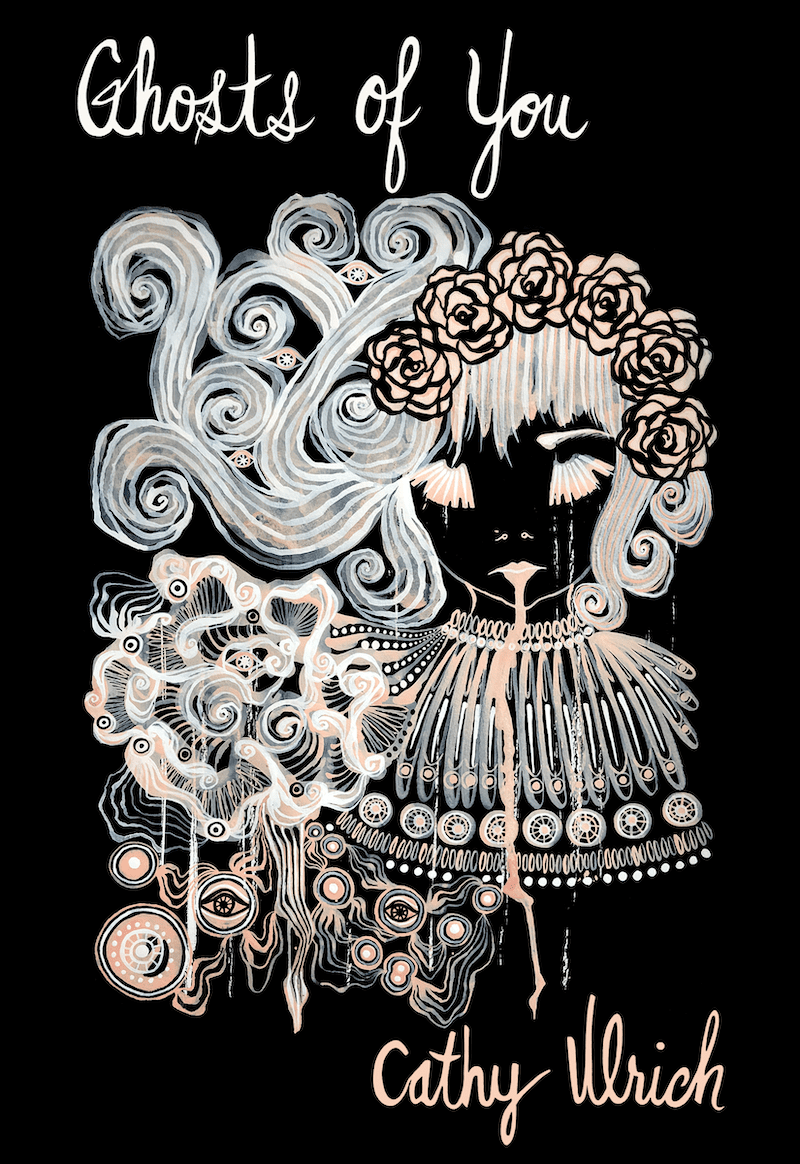I don’t remember the first story I read by Cathy Ulrich but I always remember the last one I’ve read—her stories cling to the reader long after we’ve looked away from the page. Cathy has a singularly distinct voice: lyrical yet grounded, haunting and filled with the brutality of being human yet often filled with a charming playfulness. Her series of Murdered Lady stories, now collected under the title Ghosts of You, have been appearing in journals and magazines for the last couple of years and I’ve always made it a habit to stop what I was doing and read the latest, often a few times. She uses tropes and truths in ways that make the stories seem both individual and also mythic—the fairy tales of the modern world held up to a mirror showing us all the ways in which we let women down, harm them, distort them.
Ghosts of You has just been released by Okay Donkey (the first book, in fact, from their new publishing endeavor) and it is a collection that works deeply on both the each individual story level as well as in the form of a compelling, unsettling, gorgeous whole. Ulrich speaks for victims in a way that makes us want to reach out and understand what lurks behind the headlines we so often glance over.
***
The Rumpus: Which was your first Murdered Lady piece and how did it come about?
Cathy Ulrich: The first was “Being the Murdered Girl,” published in Crab Fat Magazine back in, I think, 2015? I’d just read a story about a dead girl and the writer was musing on who she might have been before, but never really came to any real answers, and it just made me think, Yeah, being the murdered girl means you set the plot in motion. (It wasn’t intended to be a series at that point; the “sequel” wasn’t written until much later.)
Rumpus: When did you realize you were making a series of flash? And how did ordering and figuring out the book come about?
Ulrich: I realized it was a series not with the second story (a lot of my stories are connected, so if there’s only two, I consider them “sister stories” rather than a series), but when I wrote the third—which appeared in the lovely Cotton Xenomorph!—I knew this was going to be a whole “thing.”
As far as the order of the book, it’s largely chronological. Unlike my “Japan” series and the “Astronaut Love Stories” series, these stories don’t have an overarching theme or plot motion that needed to be followed. The book does end with one of my favorite pieces though—I hope readers will like it, too!
Rumpus: These are pieces that deal with the deaths of women and all the violences that comes with being a woman. What do you want people to take away from your pieces? And how do you avoid falling into tropes of victimized and murdered women in literature?
Ulrich: I’d love if these stories made people think about tropes like this—of course a murder is an interesting way to open up a story and it creates immediate conflict. But so many stories focus on solutions (or, even worse, on the killer’s point of view!) that the victim is forgotten or made unreal. They are nothing more than their murder.
I don’t know if I’m avoiding falling into those tropes myself, but I hope by making the victim the focus of these stories rather than concerning myself with resolution or motive—that I’m accomplishing what I’m trying to accomplish!
Rumpus: Your writing manages to be both distant and yet close, which gives the reader a sense of seeing these crimes from afar—what was your intent as far as tone and voice in these pieces?
Ulrich: I remember one of the stories got declined by a journal, and the editors wondered, “Why is it in second person?” But I can’t see these being written in anything but second person. It gives the illusion of closeness by making the reader the “you” in the story, but at the same time, the reader doesn’t know anything about the main character except what the survivors reveal. (And the truth is, I rarely know either!)
Rumpus: Each of your titles begins the same way “Being the Murdered…” and each story begins with the same phrase, “The thing about being the murdered […] is you set the plot in motion.” Did you worry about that repetition as you were making this into an entire collection? How do you think the repetition aids in telling these stories?
Ulrich: Absolutely I worried! When the stories are coming out a month or two apart, the repetition isn’t so noticeable, but when they’re right next to each other, it’s obvious. But a feature of my writing is repetition: in form, language and rhythm, and with these stories, especially, I think that opening really focuses the attention—both for the reader and for me as the writer—on what comes next.
Rumpus: As someone who has also spent time writing about violence against women, I know that the process can be draining. How do you try to combat the hopelessness and helplessness that comes with writing about this kind of subject matter?
Ulrich: This is a hard one! I’m not sure I could handle these stories if I were writing about what happened to these women, but writing about the aftereffects is a bit more manageable for me. That said, I like to watch fluffy television shows with good guys who save the day that have just terrible dialogue. It relaxes my brain!
Rumpus: Did you worry that by not focusing on or detailing the violence, you’d negate the horror of the situation at all?
Ulrich: I read an interview with a woman who’d been assaulted and written an essay about it, leaving out the details of her assault. In the interview, she said she realized by doing that, she left the reader in control of the details. For her, that was a mistake. For me, I’d much prefer it that way. I think the horror of the situation is inherent in the fact that these women have been killed at all—I don’t want to focus on the suffering they went through before it was over. One of the stories is based on a real, local murder, and I know exactly what happened to the girl, and I hate it, and I don’t think I could write about it. I don’t think I could bear it.
Rumpus: Do you think there are still more murdered women’s stories out there that you will want to write in the future? Or do you feel this story cycle is complete for you?
Ulrich: I wrote two more last week and started on another three this weekend. So, ah, no! Not complete at all! Ha.
Rumpus: What do you do when not writing?
Ulrich: When I’m not doing the regular day-to-day stuff (working at one of my three jobs, running my daughter to various activities, errands, household chores, etc.), I like to bead, watch silent movies, do origami, that sort of thing. I used to be in the community band, but I had to give it up for a couple of years because my daughter had so many activities I couldn’t make it to rehearsal. I’m hoping to get back to it, but I’ll probably just practice on the poor old clarinet and Eb clarinet before I show my face at practice again!
Rumpus: Finally, is there a single piece in the collection which you think is the one that the whole collection revolves around or you feel particularly strongly towards in terms of how the piece turned out or what it means to you personally?
Ulrich: The last story in the collection is one very close to my heart—it’s about missing/murdered Indigenous women. It’s a piece I finished writing and thought, Wow, I really love what I did here! I definitely don’t always think that. So it’s important to me in terms of subject matter (my birth mother was half-black, half-Chippewa Cree) and it terms of what I did with storytelling. I hope it will mean as much to readers as it does to me.
***
Photograph of Cathy Ulrich by Cathy Ulrich.





